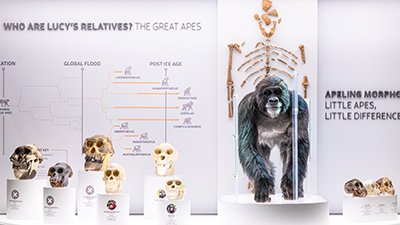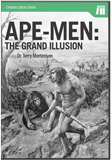
More Lucy-Like Fossils Appear in Ethiopia
News Source
- BBC NEWS: “Ethiopia Yields Ancestral Fossils”
A new “cache” of fossil remains belonging to what are described as “early human ancestors” has been discovered in the Woranso-Mille area of Ethiopia, reports BBC NEWS based on information from America’s Cleveland Museum of Natural History.1
The remains include multiple complete jaws and one partial skeleton, and have been dated to some 3.5–3.8 million years ago. Dr. Yohannes Haile-Selassie, a leader of the team that uncovered the bones, explained the discovery’s alleged evolutionary significance to the BBC:
One of the reasons why this discovery is really important is because it serves as a time frame that we know nothing about in the past and that's what makes it really significant.
We have a record of about six million years of early human evolution in Ethiopia, but there are also small gaps here and there and this one happens to be one of them.2
According to the press release, the fossils “may prove to be a bridge to establishing a relationship between the earlier Australopithecus anamensis . . . and the later Australopithecus afarensis.”3
It’s interesting to note that evolutionists only seem to acknowledge gaps (albeit “small”) in the fossil record when finding bones they feel plug one of those gaps. One also wonders how much the dating game and problematic dating methods played into the announced age of the fossils.
Not only that, but—as usual—most of the fossils are too insignificant to unquestionably buttress claims that they belong to an intermediate pre-“Lucy” form; the only fossil find more substantial than a jaw is a partial skeleton, but no information has been released regarding just how partial that skeleton is (though the press release states that it is still being excavated).
Furthermore, one wonders how these new remains differ from the long-paraded Lucy of evolutionary fame; since Lucy and others of her kind can easily be understood as belonging to a group of extinct apes, we expect the same conclusion can be applied to the original owners of these newly discovered bones. Until a full analysis of the bones appears in a scientific journal, however, all we and the public will have to go on are suddenly ubiquitous headlines heralding the new trove of supposed evidence for human evolution. It’s sad that before a detailed analysis has even been done, they are ready to trumpet their preconceived “conclusion” to the media. Apparently, they have already made up their minds before doing the research.
For More Information: Get Answers
Remember, if you see a news story that might merit some attention, let us know about it! (Note: if the story originates from the Associated Press, FOX News, MSNBC, the New York Times, or another major national media outlet, we will most likely have already heard about it.) And thanks to all of our readers who have submitted great news tips to us. If you didn’t catch all the latest News to Know, why not take a look to see what you’ve missed?
(Please note that links will take you directly to the source. Answers in Genesis is not responsible for content on the websites to which we refer. For more information, please see our Privacy Policy.)
Footnotes
- “Ethiopia Yields Ancestral Fossils,” BBC News, July 11, 2007, http://news.bbc.co.uk/2/hi/science/nature/6291254.stm.
- Ibid.
- Cleveland Museum of Natural History, “New Discoveries from the Afar Fill a Major Gap in the Early Hominid Fossil Record,” Business Wire, July 10, 2007, http://www.businesswire.com/news/home/20070710005781/en/Discoveries-Afar-Fill-Major-Gap-Early-Hominid.
Recommended Resources

Answers in Genesis is an apologetics ministry, dedicated to helping Christians defend their faith and proclaim the good news of Jesus Christ.
- Customer Service 800.778.3390
- © 2024 Answers in Genesis





